Following last week’s post, I am staying in Bethnal Green, and after finding Ron’s Gents Hairdressers, I walked to find the location of the Queen Victoria pub and the Jesus Hospital Estate. The decorative features at the top of the Queen Victoria was the subject of one of my father’s 1980s photos:

When I found the pub, it was covered in scaffolding, and whilst the royal coat of arms at the top of the pub are still there, they had been painted white:
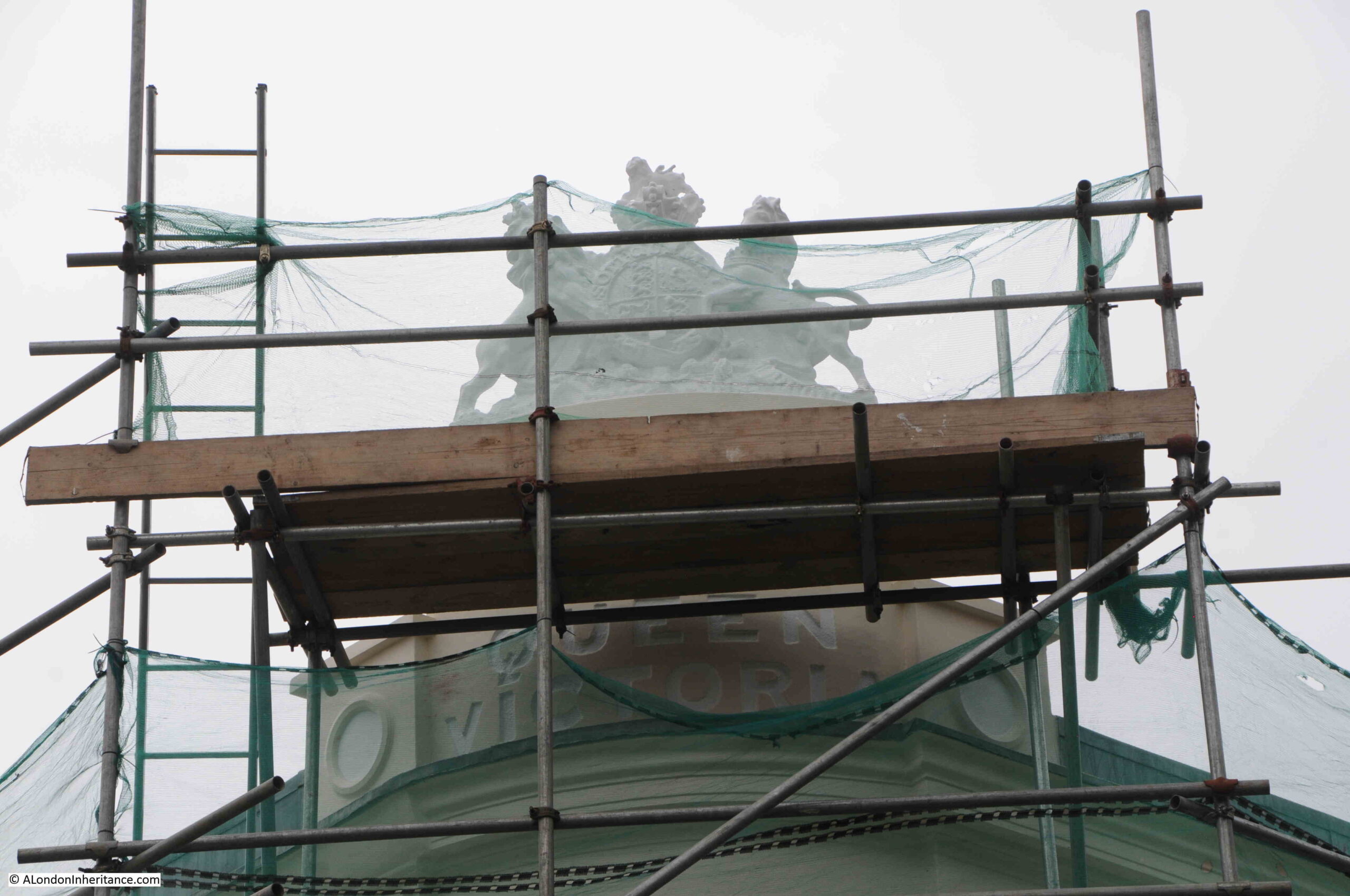
Unfortunately, my father did not take a photo of the whole pub building. I suspect due to the limited number of photos available when using a film camera. The pub today:
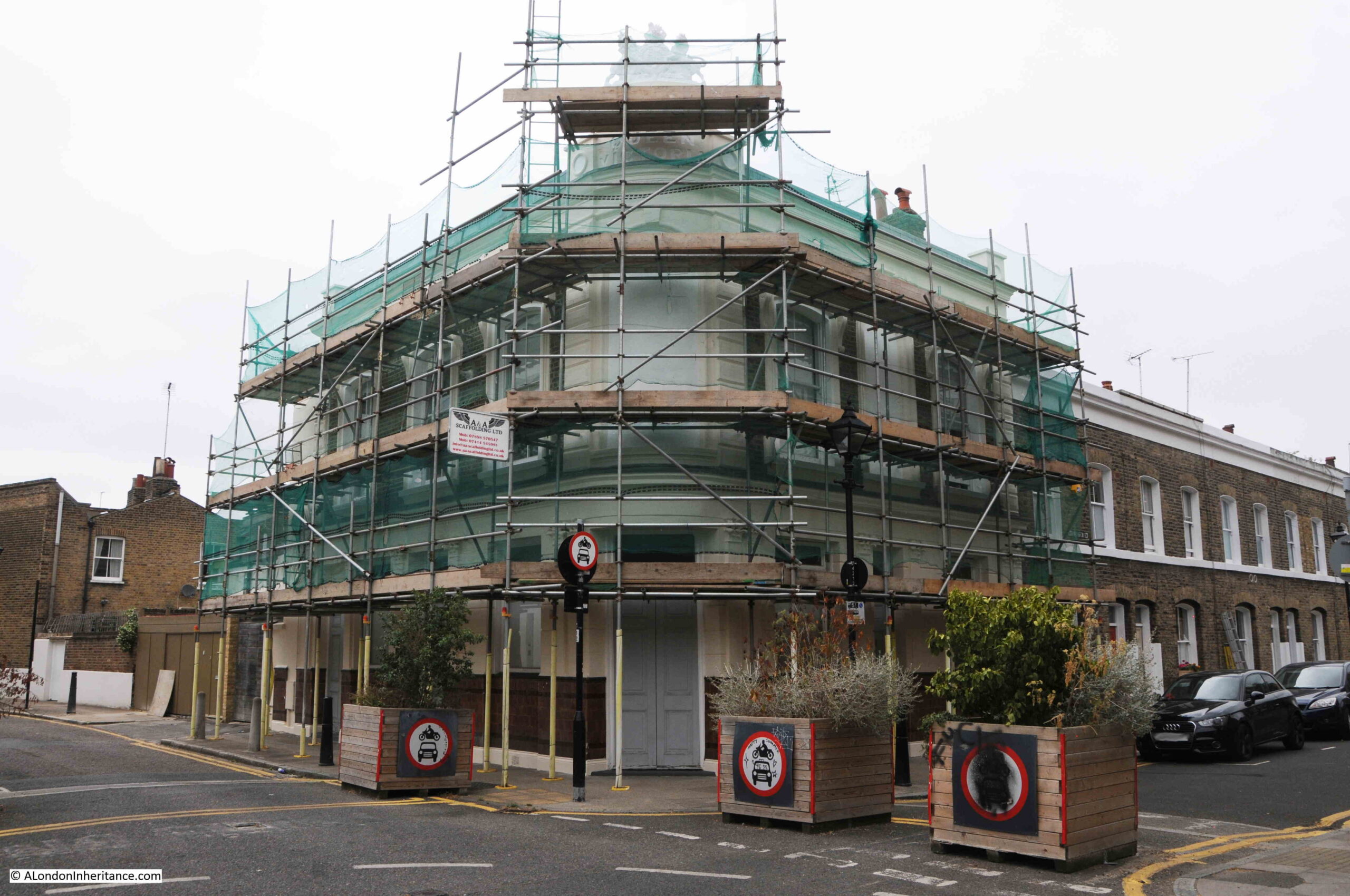
The Queen Victoria is on the corner of Barnet Grove and Wellington Row, a short walk north from Bethnal Green Road towards Columbia Road.
The pub has suffered the fate of so many pubs across London in that it has been converted to residential. The Queen Victoria closed as a pub in 1993.
I have mentioned a number of times in my posts about just how many pubs there were in London prior to the closures that started slowly after the 1940s, and accelerated quickly from the late 1980s onwards, and the location of the Queen Victoria is a prime example, as directly opposite, there was another pub:
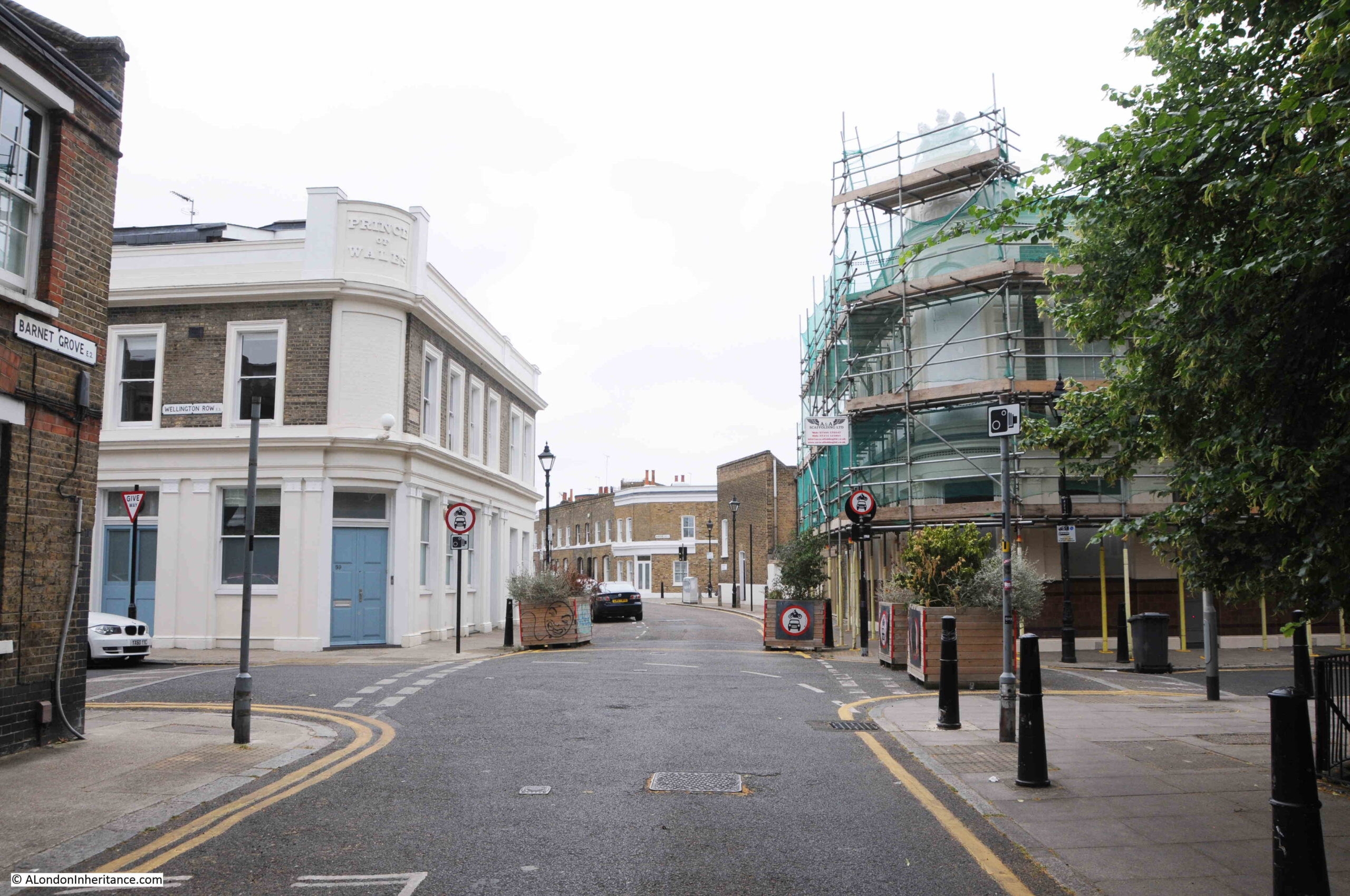
In the above photo, the Queen Victoria is on the right and the Prince of Wales is on the left, with Barnet Grove passing between them.
The Prince of Wales closed in 1995, and as with the Queen Victoria, it was converted to residential. Whilst the Prince of Wales has the pub’s name at the top of the corner of the building, there are no coat of arms:

The pub did once have the impressive arms of the Prince of Wales, as can be seen in the photo at this link from the alamy stock image site.
The building today is a shadow of its former self. I suspect the arms at the top of the pub were missing in the 1980s as I am sure my father would have taken a photo of them, as well as the Queen Victoria.
Both pubs seem to have opened in the late 1860s, and in the Hackney and Kingsland Gazette on the 28th of May, 1870, the new owner of the Prince of Wales was advertising:
“THE NEW Wine and Spirit Establishment, Conducted by the old caterer for public favour, C.H. Davies, of the ‘Prince of Wales, Barnet-Grove’, who begs to call attention of his friends and the public to his new premises replete with every comfort for the gentleman and mechanic, also to families who can be supplied with every article of the finest description including MALT LIQUOR, from the eminent Brewers of the day; SPIRITS (both foreign and British) of the highest strength and excellence, and WINES of the rarest vintage. Special arrangements have been entered into with the celebrated firm of Messrs. REID & Co. for a constant supply of their Splendid STOUT and PORTER.
Extensive and Commodious Rooms for large or small parties.
An Harmonic Meeting every Tuesday Evening at eight o’clock for gentlemen. An early visit is respectfully solicited.”
By 1907 a W. Tozer was the owner of the Prince of Wales, as in the Eastern Argus and Hackney Times he was thanking “the residents of the district and the public generally for the patronage they have accorded him since he took the proprietorship off this well known and old-established tavern 3 years ago.”
In the same article, it was mentioned that “The United Order of Druids, Baroness Burdett-Coutts Lodge (No. 948) meets at the house on the 1st and 3rd Tuesday in the month.”
The United Order of Druids was more of a fraternal and benefit society, and was open to all classes. I doubt there was much wandering around the streets of Bethnal Green in white gowns.
The branch that met in the Prince of Wales was the Burdett-Coutts Lodge. The lodge was named after Angela Burdett-Coutts, a remarkable women who was known as the wealthiest woman in the country after she inherited a fortune from her maternal grandfather Thomas Coutts, of Coutts Bank.
Angela Burdett-Coutts was a philanthropist who supported a diverse range of projects and causes. The link between the lodge that met in the Prince of Wales and Burdett-Coutts may have come from her charitable activities in the area with social housing and her founding of Columbia Market in 1869.
There are very few newspaper references to the Queen Victoria. Mostly licence changes, and in one report about an “Exciting Quoits Match”, the pub is named as the Queen Victoria Hotel, when a Mr Sayer, who appears to have been their champion Quoits player, was being challenged by Copeman and Wilstead, for £5.
The challenge was to take place on neutral territory at the May Pole in Chigwell. (Quoits is the game where a ring of iron or rope is thrown in an attempt to land it around a peg).
That there were two pubs directly opposite each other (as well as other pubs in the local area), shows the population density in this part of Bethnal Green. One of the reports mentioning the Prince of Wales covered above, may hint at the diverse range of people who lived here where the pub was advertised as having “every comfort for the gentleman and mechanic“.
In the following map, I have marked the locations of the Queen Victoria (red circle) and Prince of Wales (blue circle), and the surrounding streets show a dense network of terrace houses ( © OpenStreetMap contributors:
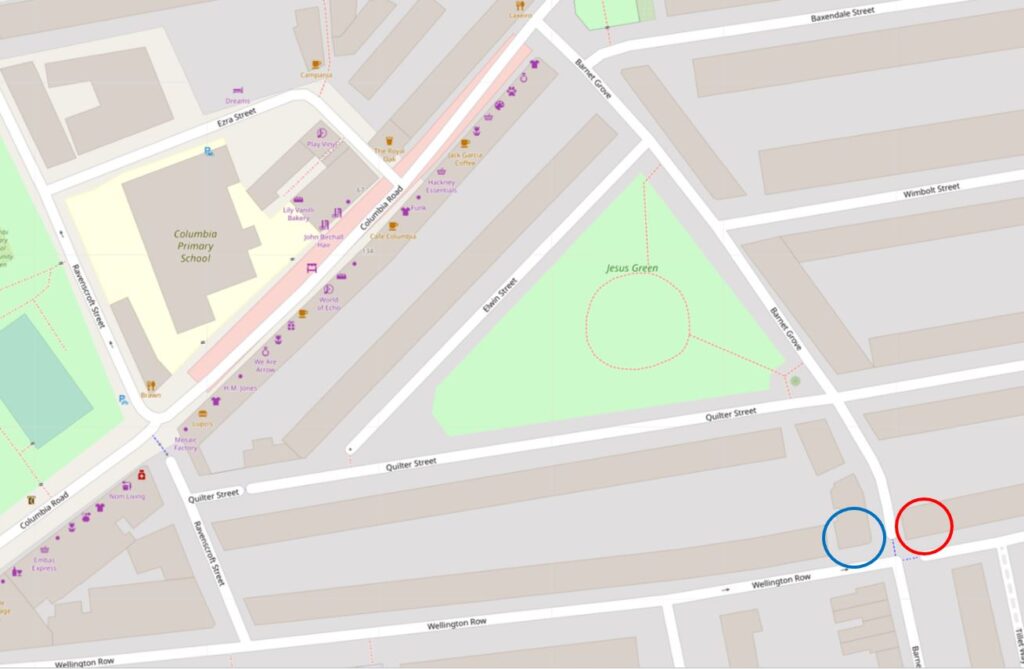
Walking north along Barnet Grove, and continuing after the Prince of Wales pub is a short terrace which still retains the shop fronts, when as well as local pubs, this street also had local shops to serve those who lived in the surrounding streets:
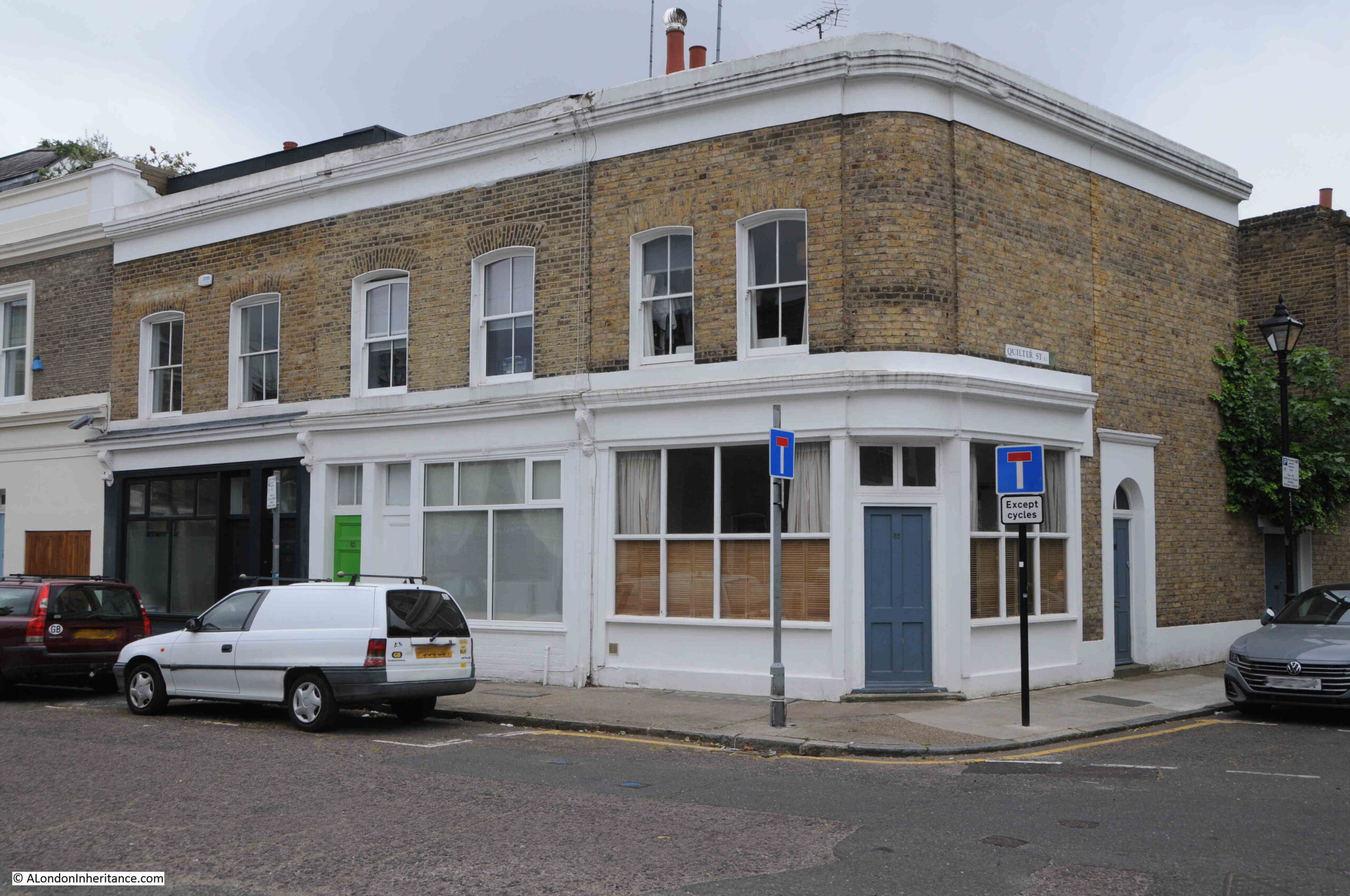
The title of this post is “Two Pubs and the Jesus Hospital Estate”, and I have covered the two pubs, but what about the Jesus Hospital Estate?
As a starter, the two pubs are on the southern edge of the “Jesus Hospital Conservation Area”, and I have marked the approximate boundary of the conservation area in the following map ( © OpenStreetMap contributors:
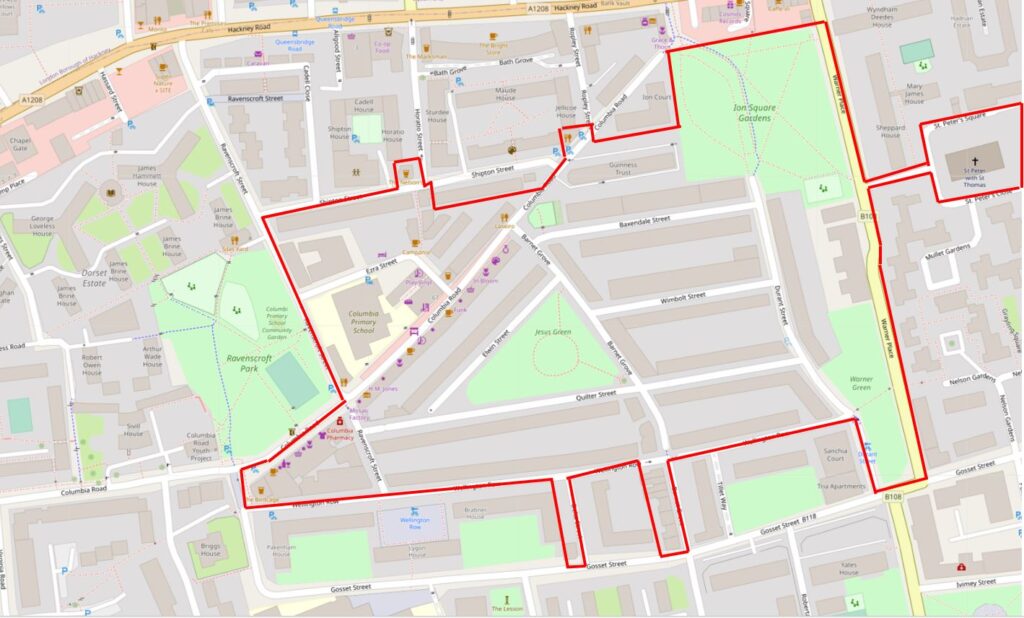
The area covered by the current conservation area has changed slightly over the years, however it started as an estate in the 17th century when the land was owned by James Ravenscroft in 1670. At that time, this was, as much of Bethnal Green still was, fields and farm land.
In 1679, James Ravenscroft founded the Jesus Hospital Charity in Barnet, Hertfordshire, and he bestowed the land in Bethnal Green to the charity.
The aims of the Jesus Hospital Charity were to provide for the support and maintenance of lady residents living in Ravenscroft Cottages in Wood Street, Barnet.
The charity is still in operation and has expanded the number of properties it owns in Barnet, and now “provides 63 unfurnished dwellings for ladies aged 50 plus, who reside alone and are fit and able to care for themselves”.
James Ravencroft’s son, George, made his name in the manufacture of lead crystal glass. He was primarily a merchant and came into contact with the glass trade after living for a couple of years in Venice.
On his return to London, he set up a glass works in the area of the Savoy, however he left the glass business in 1679, the same year as his father set-up the Jesus Hospital Charity. His father died the following year in 1680 and George died in 1683.
They were both Roman Catholics which, in the final decades of the 17th century, may not have made the family very popular.
In the early 19th century, the land was still being leased from the charity by farmers, and there had been very little change for the past 150 years, however limited building work did commence in the 1820s and 1830s.
One of the problems with the land in Bethnal Green was that it was some distance (given travel options at the time), from the trustees of the charity in Barnett. The trustees rarely visited. I assume they were happy as long as the money from leasing the land continued to flow to fund the charity’s responsibilities.
During a visit, the trustees found that the land had been developed with very poorly constructed, single storey houses, and that many were in a very dilapated condition. The streets in the area were also in a poor state, as were the sewers.
In 1862, a London surveyor based in Bishopsgate, by the name of George Clarkson was appointed to manage the redevelopment of the charity’s land.
The whole area of the Jesus Hospital Estate was cleared of the original buildings, new sewers were built along with new streets, and a total of 372 houses were built, as well as a number of pubs, including the Queen Victoria and the Prince of Wales.
It is these houses that we see when we walk the streets today.
Another old corner shop on the corner of Barnet Grove and Elwin Street:
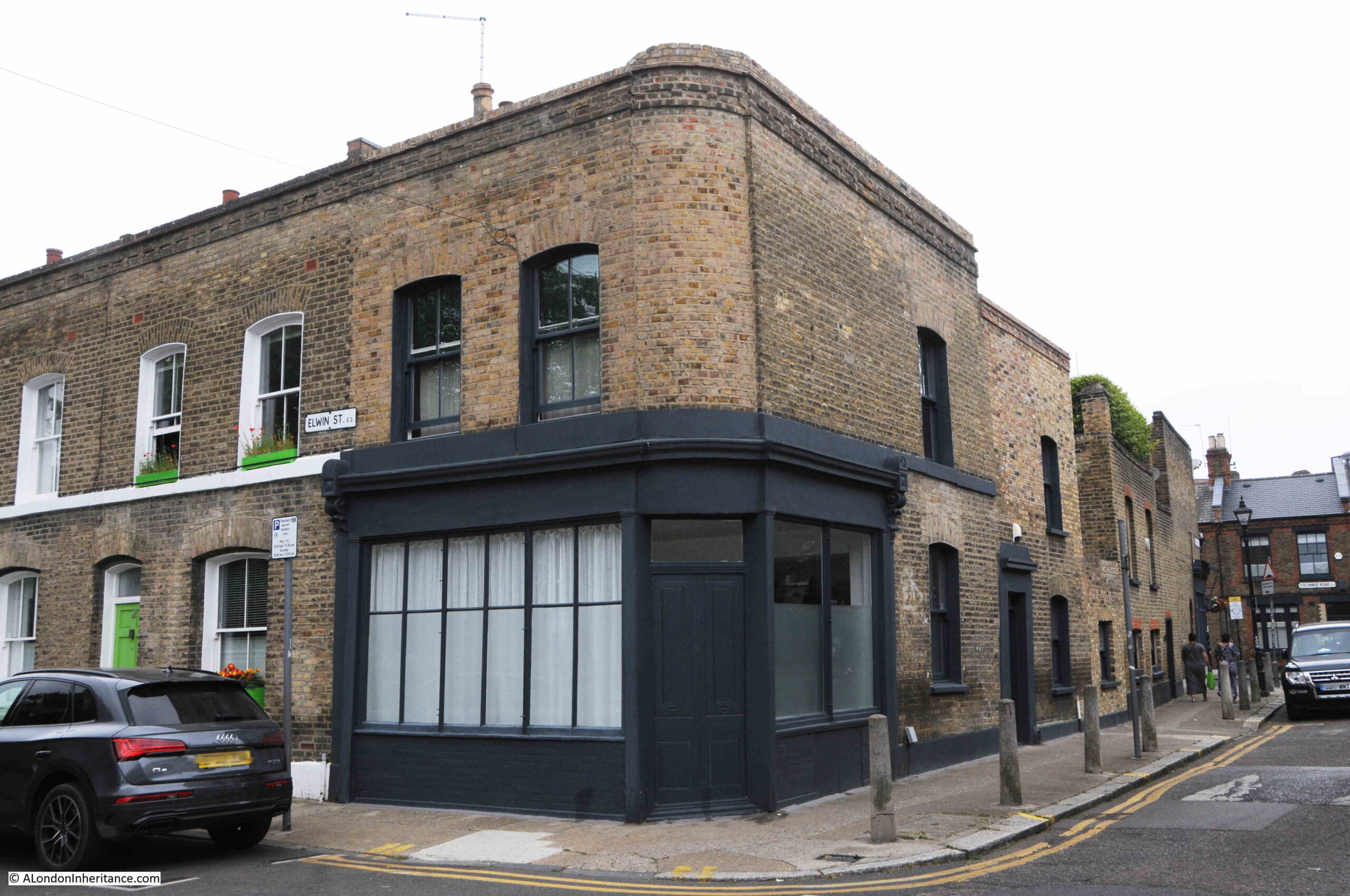
View along Elwin Street, showing a continuous line of almost identical terrace houses:

With an almost mirror image along Quilter Street, although along this street there is a slight descent in the height of the land, which is accommodated for along the terrace by a step change in height as the terrace progresses, which can be best seen by the white bar that runs along the terrace just below the first floor windows:
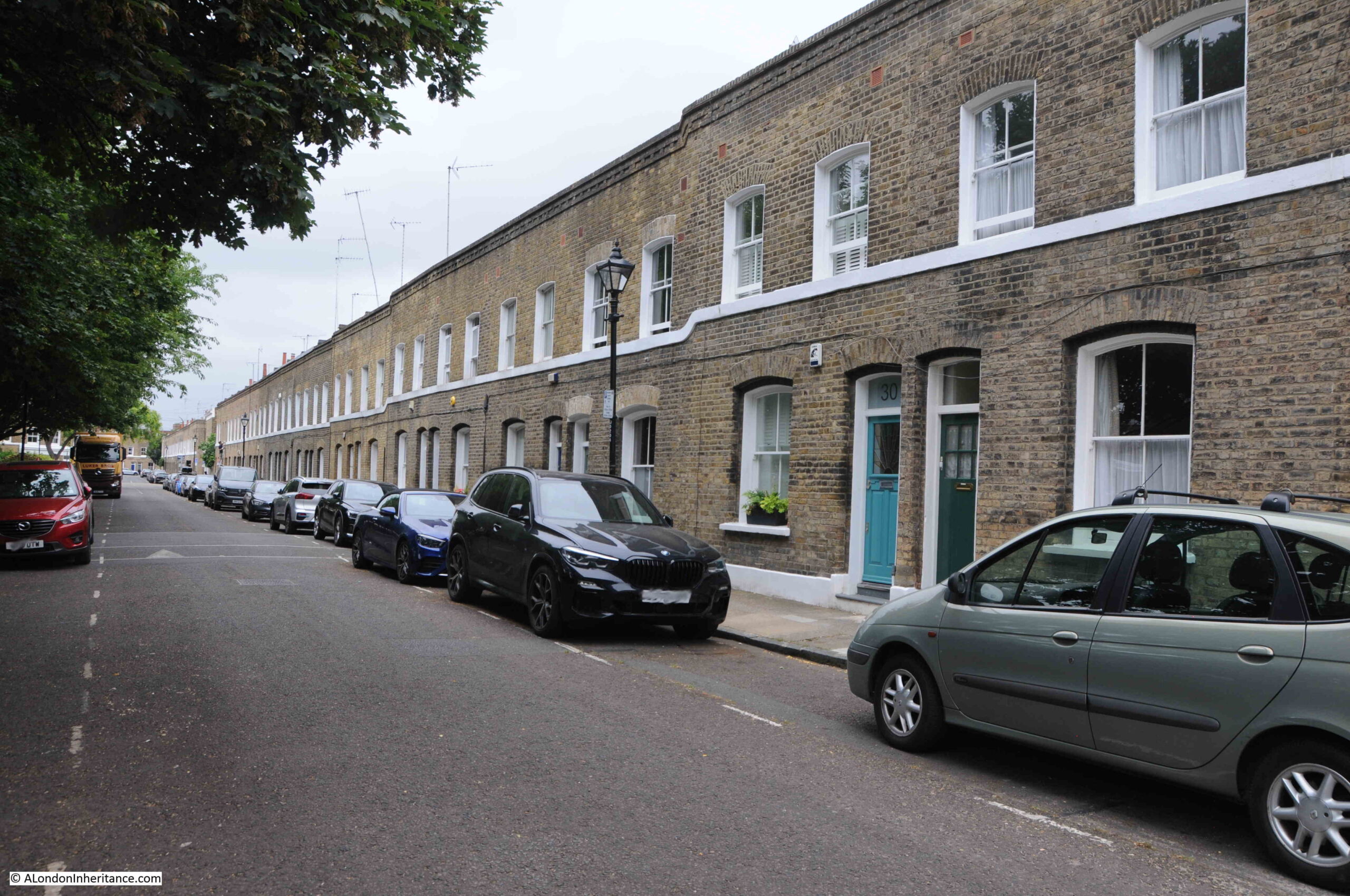
Along the street there are a couple of houses which have pipes set into the wall, with LCC which I assume is for London County Council:
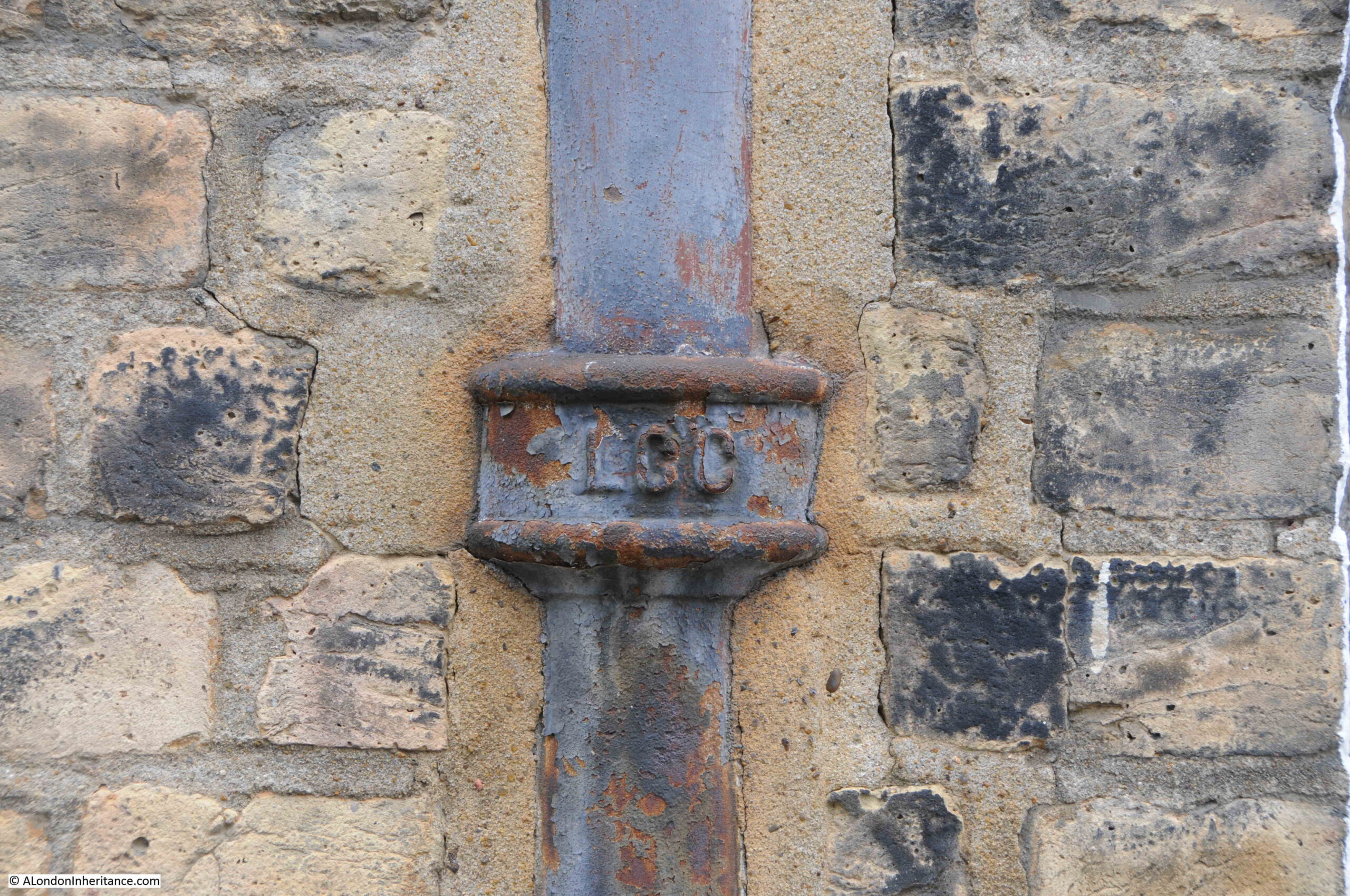
An example of which rises several feet above street level to a vent:

The London County Council never owned the houses along the street, but they would have taken responsibility for the sewers, so I wonder if they were installed as part of upgrades to the sewage system, or the Jesus Hospital Charity paid the LCC for drainage work to the houses.
In 1970, the Greater London Council served a compulsory purchase order on the land owned by the Jesus Hospital Charity. The GLC intended to demolish the estate, and there were plans to construct a large road through the area to link Victoria Park with the City.
There were ten years of legal negotiations between the GLC and the charity, and the estate was finally sold to the GLC in 1980 for a sum of £1.2 million.
Proposals for demolition were abandoned as there were many objections, including from the Jesus Hospital Estate Residents Associations which was formed in 1979 to fight against the GLC’s plans.
The Jesus Hospital Estate is today described by Estate Agents as a highly desirable place to live, and to show the incredible rise in house prices in this part of east London, in 1980 the charity sold the whole estate to the GLC for £1.2 million. Today, there is a single terrace house in Barnet Grove for sale, also for £1.2 million, so the sum you could have purchased the whole estate for in 1980 now buys you a single terrace house.
One of the reasons for the Estate Agents description of the area is that there is a large triangular green almost at the centre of the estate:
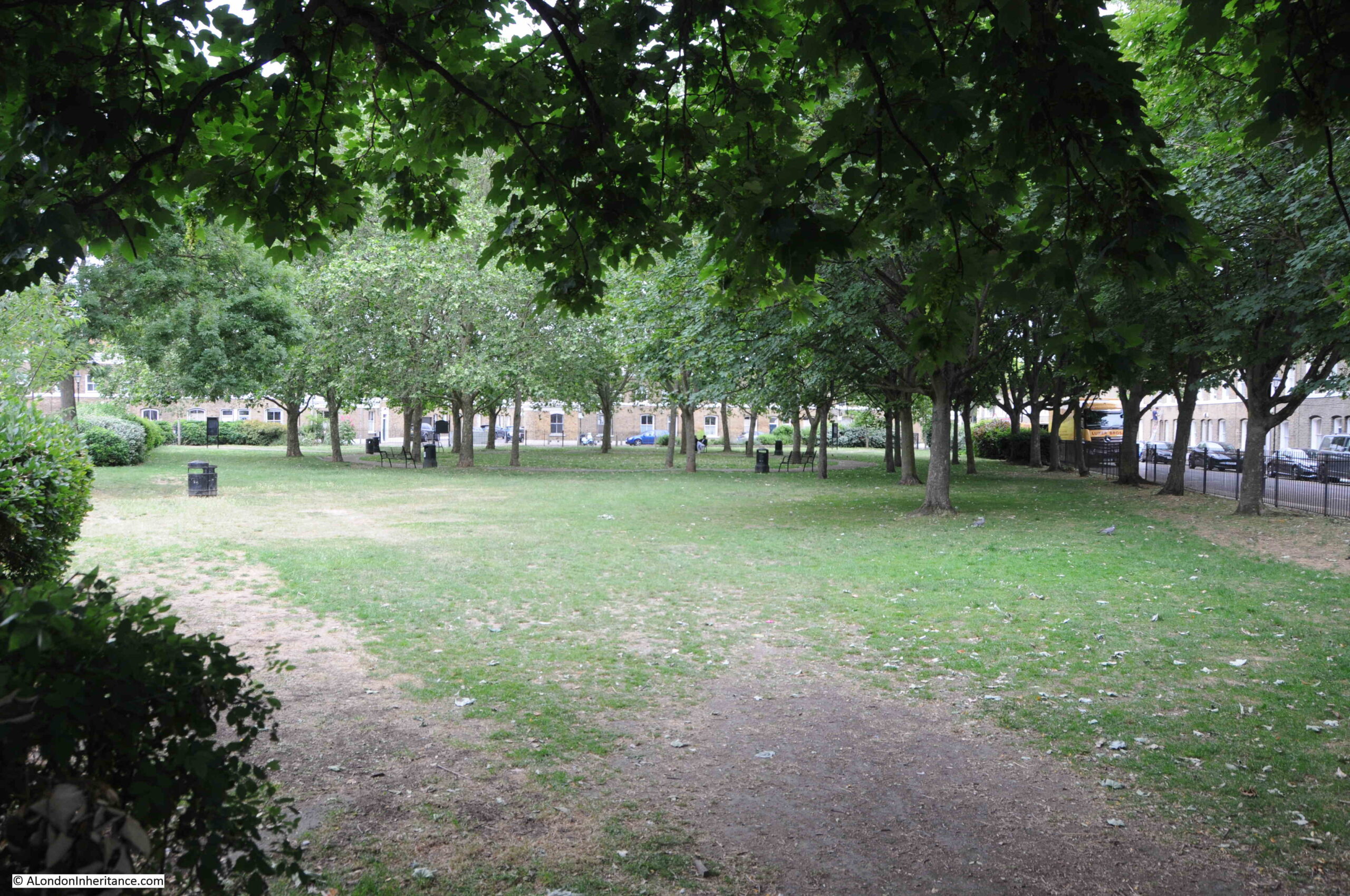
This is Jesus Green, but it was not part of the original 1860s development, when the 19th century approach was to pack as many terrace houses into the area as possible.
In the 1949 revision of the OS map, the area covered by Jesus Green today, is shown as a dense area of terrace houses, with an archway under one the houses in Barnet Grove leading into a central courtyard which housed a number of workshops (‘Reproduced with the permission of the National Library of Scotland“):
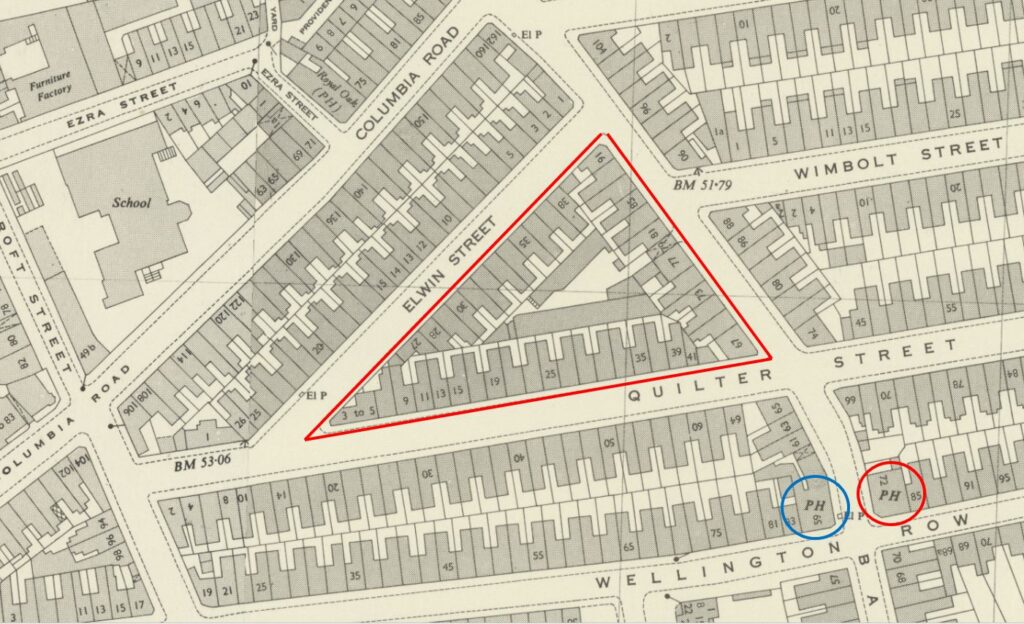
I cannot find an exact date, or reason for the demolition, however I believe the houses in this central triangle, outlined in red in the above map, were demolished in the 1970s. The LCC Bomb Damage maps show that this central area was almost untouched, so whether demolition was part of the GLC’s rebuilding plans, or for some other reason, I do not know.
I assume that after plans for demolition, road building and redevelopment were abandoned, the central area was turned into the green space it is today.
We can get an idea of what the streets surrounding the central gardens looked like before the houses in the centre were demolished.
The photo below is the view looking east along Quilter Street from Barnet Grove. There are terrace houses along both sides of the street. Quilter Street continued behind where I was standing to take the photo, but today, the central gardens are on one side and terrace houses on the other.

The name of the open space, Jesus Gardens is a reminder of the charity that owned the land for around 300 years. There are also a number of other reminders in the street names, for example;
Barnet Grove is obviously a reference to Barnet in Hertfordshire, where the charity was based, and where money generated by leasing the land in Bethnal Green was used to fund the homes for women. Barnet Grove predates the 1860s redevelopment so is one of the oldest streets, and street names in the estate.
Quilter Street is named after James Quilter, a solicitor, who was one of the charity trustees, during the 1860s redevelopment of the estate.
Elwin Street was named after the Reverend T.H Elwin, who was the Chairman of the charity at the time of the redevelopment.
The earlier pub advert referred to “the gentleman and mechanic”, so I had a look in the 1921 census to see who was living in Quilter Street, one of the streets of the Jesus Hospital Estate. A very brief sample:
- At number 34 was Philip Samuel Hurman, aged 45 and listed as a French Polisher for Bradstad Brothers Pianoforte Manufacturer, along with his wife Esther (45), his son Philip Samuel (21) a Carman for Saunders & Nephew Provision Merchants, a daughter Jane (19) who was a Trousers Machinist for Lockwood & Bradley Wholesale Tailors, and a daughter Ivy Lilian (15) who was a Card Board Box Maker for Wright Brothers, Box Manufacturers
- At number 47 was Frederick Tayor, aged 66, a retired Brewers Cellarman, along with his three daughters, Emily (34), Ellen (32) and Amy (28) who were all Tie Makers, working for J. Paterson.
- At number 64 was Charles Moore, aged 40, an out of work cabinet maker. He was living in the house with his wife Emily (45), daughters Emily (20) and Rhoda (15) who were both listed as a Tailoress for Rego Clothing Company, and his son James (18) who was a Labourer for a Mr. Loveday, Glass Silverer
- At number 90 was Wallace Henry Norris (32) who was a Carman for J.E. Read, Carman & Contractor, along with his wife Elizabeth (28) listed as having Home Duties, and their one year old daughter Ada May. There were also three sons aged 14 and below. the 14 year old son was listed as just having left school.
A very small sample of the thousands who lived in the streets of the estate, but they are typical of all I looked at. Manual workers, employed from a young age and the majority working in one of the very many manufacturing industries that were to be found around Bethnal Green in the 19th and early 20th centuries.
The Jesus Hospital Estate is a fascinating area, away from the bustle of Bethnal Green Road and Columbia Road, an estate which owes its existence to a charity in Barnet, Hertfordshire, and an estate that narrowly avoided full demolition by the GLC in the 1970s.

Thank you, I find this area of London very interesting.
You can still buy ‘LCC’ cast iron pipe and fittings. Is it an acronym for something other than the London County Council?
Norma.
Until two years ago my Aunt Win lived in Ravenscroft Cottages, Barnet.
She moved in on the death of her husband in the late 1980’s.
When she was 100 the charity held a party for her in the cottage grounds.
I also had another aunt who lived in Barnet in charity property.
Four new cottages have recently been built in Barnet, and the design and
building standard is wonderful for the older residents.
Another great blog. The GLC’s very controvercial. I live in Covent Garden. When the market closed down. They wanted to demolish it!!!! They wanted to blitz the area. I’m so glad they didn’t. I live on Kemble St. My building used to be a hostel for homeless men. It had a bit of a reputation. It was full of dormitories. Very ‘rough & ready’ men would be hanging out of the windows. Drunk on whisky & wine!! Then in 1995 my building was converted into flats. But half of the building is housed by a charity for the homeless & i’m part of the other half. (Peabody Housing Association). Maybe you could do a blog about the old homeless hostels. There were loads in London. If the GLC had got their way. My lovely building probably would have been demolished & they would have turned beautiful old Maiden Lane into some awful modern, characterless rd. They wanted to turn the market into some horrible modern offices & flats. But thank God the residents formed the Community Association. Fought them & won. I always tell people about a lovely documentary about how the market changed. But it’s very sad. All the lovely businesses that had been there hundreds of yrs had to close. It’s only about 30mins. But it’s a very sweet film. They go to a lovely old pub i go to now, on Endell St. (The Crosskeys). I might be going there tonight! It shows you some ‘old dears’ sitting drinking their gin & whiskies singing My Little Room in Bloomsbury!
Great article. I live on Holly Lodge Estate in Highgate also built and owned by the Coutts trust.
Just for info, the Queen Victoria picture is one of a number found in a skip and forms part of the Charrington brewery pictures available for free. I have no idea how alamy claim a cost for usage. I have a considerable number of pictures on my pub history sites which are in the public domain, a link is always welcome.
My history of the pubs is also unique, although a little lacking after 1944.
Kevan
What’s the URL of your site please ?
All very interesting.
What do you suppose the “Harmonic Meeting” refers to? Is this different from the Druid lodge?
when there are two pubs in close proximity i was told one would be an ale house and the other would serve both ales and spirits this came from my mother who grew up in shepperton rd where there are to pubs adjacent to each other they were always known locally as the ones and twos they were actually the soutgate arms and the rosemary branch
As for the ‘Three-Colts’ street name, I think these were quite common across London. Three Colts Court, off Worship Street, Shoreditch, is another one, although it no longer exists
I would just like to register my fascination at your photographs, content and knowledge of the surrounds, today and way back when
I enjoy every moment that a new post of yours pops up and I get the chance to read and take it all in
Thank you
Fascinating. Thanks for posting!
Another fascinating post and another big thank you. As you say this pattern of pubs is replicated across the East End. My grandfather and his brother had pubs in Hackney. One was the Duke of Devonshire (I’m referring to the pub and not my ancestors) on Darnley Road and that has the name in a similar style above the cornice. And of course it is now residential. The Palmerston on Well Street, my grandfather’s pub, is now Well Street Pizza. A photo of how it looked also appears on Kevan’s website and, like Kevan says, is from the same series of pub photos that Charrington made and which Kevan says he rescued from a skip. Judging by the cars on the photo of the Palmerston they appear to have been taken in the late 1940s / early 1950s.
Kevan’s site is well-worth visiting for pub histories, including census data for a huge number of pubs. It’s a labour of love! He has also been of help in allowing me to use photos for articles that I write. Commended! The Charrington photo of the Prince of Wales is at https://pubwiki.co.uk/LondonPubs/BethnalGreen/PrinceWales.shtml
Another of my grandfather’s pubs was the Bishop Bonner on Bonner Street, Bethnal Green, almost opposite the Bonner Arms. The Bonner Arms is gone but the Bishop Bonner still looks like a pub even though it is inevitably residential.